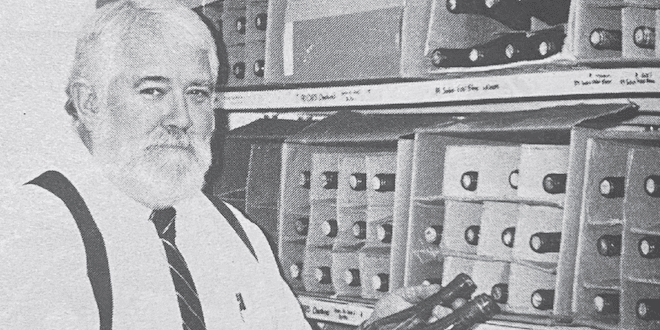

Nov 3, 2021Grape industry changes seen in 1995
A Michigan State University (MSU) professor of horticulture had some predictions for the future of the grape industry that he shared in a 1995 presentation.
Stan Howell said at the time that the Eastern United States grape industry will look different in the year 2025, with the possibilities even including vineless grapes.


After 25 years of working on the major issues of Michigan grape and wine production, Howell looked ahead into the next century in a presentation at Southwest Michigan Hort Days at Lake Michigan College in Benton Harbor, Michigan. The talk was recapped in the February 1995 issue of The Great Lakes Fruit Growers News, the predecessor of the Fruit Growers News.
Predicting the future was a risky enterprise, especially when considering the events of the previous 25 years, few of which were reasonable expect when Howell began in 1969.
“I could not have anticipated the change in Concord culture, the rise in importance of Niagara for white juice, the expansion of hybrids and vinifera cultivars for wine to the virtual exclusion of Concord, Niagara and Delaware. These latter three had been the basis for 95% of Michigan’s wine in 1970 and accounted for less than 5% in 1993,” Howell said.
No one in 1970 would have suggested that commercial grape production in the state would take place anywhere other than in Southwest Michigan. Today, there are acceptable winegrape sites in almost every county bordering Lake Michigan from Berrien in the south to Grand Traverse and Leelanau in the north.
More changes of this magnitude can be expected to occur in the future of the Eastern grape and wine industries, said Howell, especially in the area of pest control, the environment, consumer fads, education and economics.
Fewer tools will be available for insect, disease and weed control in 2025. The Swiss are already dealing with that reality with a practice called integrated viticulture. The goal of this practice goes beyond pest control to the development of an ecologically sound approach to grapevine culture that includes integrated pest management, vine nutrition, canopy management, training system choice, crop control and vineyard floor management.
“This is a subtle but significant emphasis shift – we desire to manage grapevine production and fruit composition and quality. Such an approach will require a much more intense approach to viticulture by 2025,” Howell said.
Other environmental forces driving change in the industry will include soil water quality and waste management.
Soil water quality has already achieved paramount importance in Western
states, where use of some soil fumigants and herbicides is banned. The European situation where vineyard and population centers are in close proximity suggests nitrate nitrogens may also be a future concern, Howells said.
“This would be especially true in areas with coarse-textured, well-drained soils and moderate to high rainfall – like we have in Michigan,” he said. “The European experience suggests that we must be concerned and careful if we are to avoid well water (nitrate) problems by 2025.”
A different approach to vineyard nutrition may be coming. Growers may use frequent “spoon-feeding” applications, use fertigation through drip irrigation system, or a method such as the vineyard floor biomass manipulation currently being used in Switzerland.
The issue of waste management at juice and wine processing facilities must be resolved before 2025, Howell said. This is of concern to growers because problems with value-added processing will limit the ability of processors to pay growers top prices per ton of fruit and remain profitable.
The current trend of reduced research, development and grower education will continue, Howell said. Land-grant universities, their colleges of agriculture, experiment stations and Extension services nationwide are all down-sizing. A continuing legacy of industry leadership, such as that provided by the National Grape Cooperative and the Michigan Grape and Wine Grape and Wine Industry Council, helps fill the void.
The future holds a further reduction in research, development and grower education, Howell said. Corporate support will be limited, and when a food funding source appears, it will attract interest from broad areas of research and not just from those who can solve grape-wine industry problems.
On a positive note, regional cooperation will be increasing, Powell said. New York and Pennsylvania have already created a regional grape research station. Michigan, Ohio and Indiana have started discussions, as well.
The tension between the quantity of fresh crop produced and quality of the processed product will continue to intensify. Efforts will continue to find mechanized approaches to vine pruning, along with mechanical, caustic and chemical means of crop control.
“These efforts are crucial if the economics of producing Concord and Niagara grapes are to remain acceptable. At current prices per ton, many growers cannot survive unless production costs per ton are reduced,” Howell said.
Juice and wine processors are in a fierce contest for market share. Better quality fruit will be demanded for production of higher quality juice and wine, and processors are likely to take stops such as increasing the minimum sugar level in the raw crop.
Plenty of positive features will be found in the future of the industry, Howell said. The Swiss are leading the way in growing grapes successfully with fewer chemical inputs. The increasing trend toward regionalism will create new niche markets for the industry. The potential also exists for biotechnology to play a positive role.
Other possibilities are much more futuristic, including the notion of vineless grape production. Currently, a grapevine can be developed from and individual callus. A root cell, leaf cell, wood cell and berry cell all have the same genetic complement. They differ because specific genes are activated or repressed. Biotechnology has the potential to develop a callus to ripe fruit in the absence of a vine.
Another possibility is the replication of genes to change canopy leaf orientation form the current right angle to the sun to being parallel to the sun’s rays. This would improve leaf photosynthesis, improve spray penetration and lessen the amount of humidity within the canopy and reduce the risk of disease.
Top photo: The future of the Eastern United States wine and grape industry was expected to be much different in 2025, according to a 1995 presentation by Stan Howell, Michigan State University professor of horticulture. Photo: The Great Lakes Fruit Growers News














